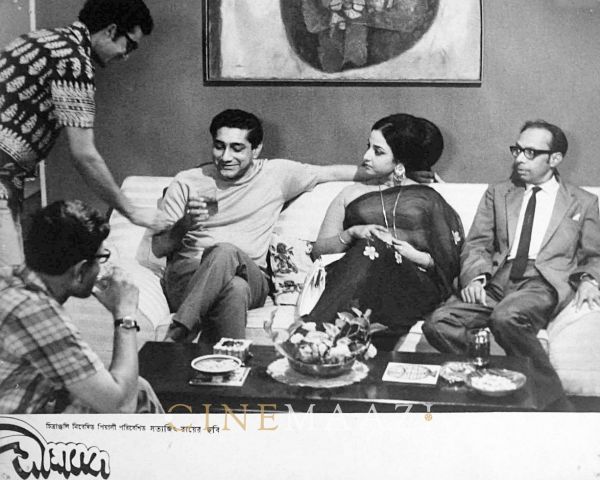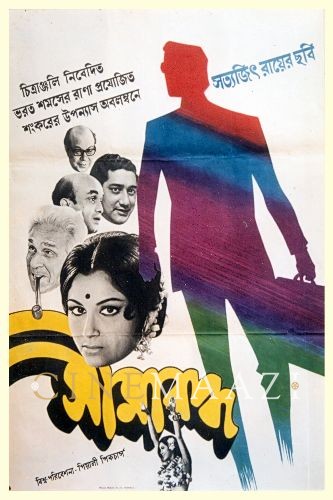Fifty years after it was made, Satyajit Ray’s Seemabaddha continues to remain a trenchant take on the corporate rat race. Barun Chanda, who made his acting debut in the film, remembers how he came to be a ‘Ray Hero’.
I know what you are going to say. Even if you were to employ my technique, there’s no way you can become a Ray hero for the simple reason that he isn’t there anymore.
Agreed. However, what if the technique I advocate works with others as well? What, if you could bag a meaty role with other directors simply by emulating my approach? So, here it goes, for whatever it’s worth.
I always wanted to be an actor, specially a Ray actor. The problem was: how do I meet up with him? My young pride prevented me from climbing those dark wooden stairs and knocking at the door with a fervent plea: ‘I want to act in your movie.’ Surely, that couldn’t be a position of strength for me. He could simply turn around and say, ‘Sorry, I don’t have a role for you, at least not in the coming movie.’
At that time, I was working in an ad agency and knew Desmond Doig, the editor of a youth magazine called Junior Statesman. So, I went up to Desmond and offered to interview Ray on behalf of his magazine. To my great delight, Desmond agreed.
Now I had a genuine reason to meet Ray.
Now, this was a tricky position. My tape recorder had gone kaput and I couldn’t possibly borrow pen and paper from Ray, could I? So, I decided to go ahead with the interview anyway and trust my memory to record it.
Luckily, the interview came off well. Ray was impressed that I had managed to reproduce an almost hour-long interview from memory without any major faux pas. So impressed in fact that when he decided to cast me for the hero’s role in Seemabaddha, he simply wouldn’t trust me with a script for fear of my memorizing all the lines.
However, I am jumping too much ahead. So, let’s go back to where I left the story. Sometime after the interview, I came to learn that Ray had chosen Shankar’s (Monishanker Mukherjee) Seemabaddha as his next film project. I had definite proof of that shortly enough. Ray would call me up and ask me to meet him to discuss some advertising details related to his upcoming movie.
Encounter of a different kind
I was in seventh heaven. With luck I might have my name tucked away somewhere in the credits. But, surprise surprise, one afternoon he called me up and asked me to meet him at his residence. This time there wasn’t any assignment. Just a pleasant chat. And then, out of the blue, came the question, ‘Barun, you haven’t ever considered acting, have you?’
After the briefest pause, I quipped back, ‘I haven’t ever said no, have I?’
He didn’t actually say, ‘Touché!’ But his breaking into a loud ‘Ha ha ha!’ was acknowledgement enough. He then took out a fat ‘Shalur Khata’ (a red cloth-bound writing pad, much favoured by businessmen for maintaining daily accounts) and said, ‘I’m going to read out the script of Seemabaddha to you.’

If he was disappointed with my response, he didn’t express it. Perhaps, he understood my predicament. ‘But don’t think it’s final. You still have to go through an audition. After that we’ll see.’
Auditions are a kind of aptitude test, especially relevant for the first-time actor. You might look impressive for a particular role. But in front of the camera you might just freeze.
Well, in due course of time I passed that aptitude test as well. Ray was shooting Seemabaddha in a chronological order. I guess it helped the actors to sink into the role as the shooting progressed. It was natural, then, that our shooting should commence in Patna, to show my past in flashbacks.
My first ‘brownie’ point as an actor
In Patna, acting was, by and large, a breeze. All I was required to do was to ride a bicycle through different parts of the city, which I managed to perform reasonably well. And then came my first bit of improvisation as an actor, something that Ray hadn’t asked me to do. It happened when I was headed for an interview with Hindusthan Peters, straight from my college where I used to teach. On the way, it suddenly dawned on me that this fellow should be quite anxious to reach the venue of the interview on time. So, at the last moment I decided to take a quick look at my wristwatch. Babu (Sandip, Ray’s only son), with whom I became quite friendly later on, told me that my little ‘touch’ with the wristwatch hadn’t gone unnoticed by the master.

It happened early enough after our return from Patna. Dolan, my screen wife, and I were supposed to pick up my sister-in-law, Sudarshana, from Howrah Station. For some time I had been taking driving lessons in those specially souped-up driving-school cars, with the comforting presence of the trainer by my side. But those lessons, taken early morning when traffic was minimal, was one thing. This was entirely different. For it involved driving across Howrah Bridge and Dalhousie Square, while carrying on a conversation with my sister-in-law. I was terrified. How could I, a novice, drive through Howrah Bridge with the mad traffic all around me? What if there was an accident? In desperation, I begged Ray to shoot it in ‘back projection’, a process whereby one can shoot the whole thing in the studio while still giving the impression I was driving through the road. Ray wouldn’t hear of it. Finally, I threw what I thought was my ultimate punchline. I wasn’t insured. Was he? Ray acted deaf.
That day the gods must have taken pity on me. For, somehow I managed to drive through the dense traffic and still remembered to deliver my lines in the right places. Finally, the car stopped on its own near Victoria Memorial. It had enough of my ineptitude behind the steering wheel for the day. Luckily, by then, all my speaking lines had been delivered to Ray’s satisfaction.

It seemed, in no time at all, our shooting was coming to an end. The day I am declared a director of the board of the company I return home early in the evening. I had already conveyed the good news to my wife. When I reached my residence, however, something unpleasant awaited me. The lift was out of order. Meaning, I had to climb up the stairs all the way to the tenth floor. Like many other elements in the script, this part wasn’t there in the book.
True to form, Ray climbed the stairs all the way to the tenth floor with me, never bothering to take the lift.
Later in the evening, I meet up with Sudarshana, my sister-in-law, desperate to impress upon her my newly exalted position in the company. However, she has already inferred that my rise to the top is tainted with a series of unethical steps. She takes off the wristwatch I had given her to wear and leaves me. I am left lonelier than ever in my life. That’s how the movie ends.
The impact of Seemabaddha
My life can be divided into two clear parts: before and after Seemabaddha. Life after Seemabaddha was intrinsically different from what had gone before. It was marked by extra confidence. For a while, nothing seemed to be beyond me. And, most importantly, I was marked, for life, as a Ray actor. Even after fifty years, people still come and warmly greet me, praising me for my acting in the movie.
As my friend Pradip Mukherjee, the hero of Ray’s Jana Aranya is wont to say with pride: ‘Us Ray actors are a different breed … the last of the Mohicans.’
Tags
About the Author

There have been three enduring passions in Barun's life, advertising, acting and writing, but not necessarily in that order. With a master's degree in English from Jadavpur University he was in advertising for more than three decades, winning numerous accolades and awards as a creative director. Acting happened to him as a happy accident. Chosen by Satyajit Ray to play the role of the protagonist in Seemabaddha, he put up an inspiring performance to bag a special President's award for his acting.
After a hiatus of nearly two decades he came back to the screen with a string of arresting performances in both Bollywood and Tollywood. Writing has been the third abiding passion in his life. At one time a regular film reviewer and feature writer for major dailies, he has so far published four acclaimed novels in Bengali and two in English, Coke and Murder in the Monastery, both crime thrillers. He is working on his first non-fiction book, Ray on My Mind.







.jpg)


